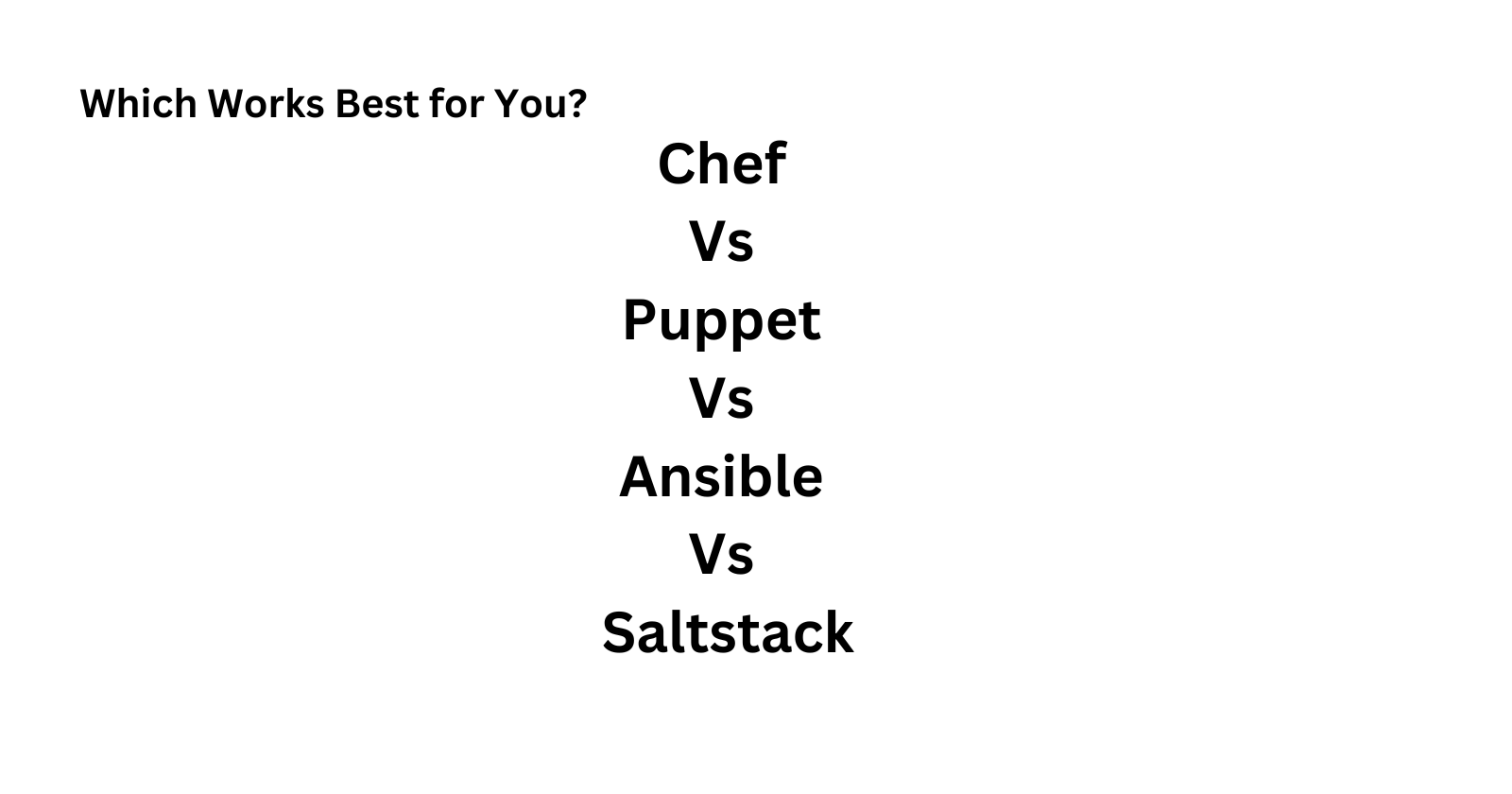Chef Vs Puppet Vs Ansible Vs Saltstack
 Amrutha D
Amrutha D
The features and characteristics of four popular configuration management tools: Chef, Puppet, Ansible, and SaltStack. It compares them in terms of their key attributes and use cases. Here's a breakdown of each question and answer without a plagiarism check:
What is a Chef?
Chef is a powerful configuration management tool that automates the deployment and configuration of software and infrastructure in a repeatable, scalable, and predictable manner. It uses a declarative language called "Cookbooks" to define the desired state of the system and then applies these Cookbooks to the target system using a client-server architecture. Chef also provides tools for testing and validating the configuration and monitoring the system's state over time. It is suitable for automating infrastructure management and maintaining complex software systems.What is Puppet?
Puppet is a configuration management tool designed to automate the deployment and management of software and infrastructure in a scalable, repeatable, and efficient manner. It uses a declarative language called "Puppet code" to specify the desired state of a system and applies this code to target systems using an agent-based architecture. Puppet offers features for configuration management, provisioning, compliance, security, reporting, and monitoring. It is a powerful tool for managing infrastructure at scale.What is Ansible?
Ansible is an open-source IT automation tool that simplifies the process of configuring and managing servers, applications, and network devices. It uses human-readable language and YAML-formatted playbooks to describe complex IT workflows. Ansible works via SSH or PowerShell to connect to remote machines and execute tasks or playbooks. It is agentless, meaning it doesn't require software installation on target machines, making it easy to use and deploy. Ansible is suitable for automating various tasks involved in managing complex IT environments.What is SaltStack?
SaltStack is an open-source software configuration management tool that automates the deployment and management of software infrastructure. It uses a client-server architecture and a system of configuration files, templates, and scripts to manage systems. SaltStack is known for its scalability, flexibility, automation capabilities, and security features. It can manage large-scale systems and various types of devices, making it ideal for complex infrastructure management.Comparison of Chef, Puppet, Ansible, and SaltStack:
This section provides a comparison table that summarizes the key features of the four tools in terms of language, agent-based or agentless nature, master/agent mode, community support, learning curve, platform support, scalability, configuration files, resource declaration, idempotence, dependency management, integration with other tools, use cases, and suitability. It concludes that the choice between these tools depends on specific organizational needs, deployment scale, and team skill sets. Chef and Puppet are agent-based and suitable for complex, large-scale deployments, while Ansible is agentless and more lightweight, making it ideal for simpler configurations. SaltStack, also agent-based, is highly scalable and suitable for large-scale, complex, and dynamic deployments.Comparing Chef, Puppet, Ansible, and SaltStack:
Language: Chef uses Ruby, Puppet has its DSL, Ansible uses YAML, and SaltStack relies on Python.
Agent-based: Chef, Puppet, and SaltStack use agents, while Ansible is agentless.
Master/Agent Mode: Chef, Puppet, and SaltStack operate in a master/agent mode, while Ansible connects directly to remote systems.
Community Support: All four have active communities.
Learning Curve: Chef and Puppet are more complex, while Ansible and SaltStack are easier to learn.
Platform Support: All support a wide range of platforms.
Scalability: SaltStack excels in scalability, ideal for large-scale and dynamic deployments.
Configuration Files: Chef uses "Cookbooks" and "recipes," Puppet uses "manifests," Ansible uses "playbooks," and SaltStack uses "states," "pillars," and "grains."
Resource Declaration: All ensure idempotence.
Dependency Management: Chef, Puppet, and SaltStack have dependency management features, while Ansible relies on YAML playbooks.
Integration with Other Tools: All integrate well with other tools and systems.
Use Cases: Chef and Puppet are suited for large, complex deployments. Ansible is for simple configurations and cloud deployments. SaltStack excels in large, dynamic environments.
In conclusion, choose the tool that fits your organization's needs, deployment scale, and team expertise. Each tool has strengths and can efficiently automate infrastructure management, but the choice depends on your IT environment's context and requirements.
Subscribe to my newsletter
Read articles from Amrutha D directly inside your inbox. Subscribe to the newsletter, and don't miss out.
Written by

Amrutha D
Amrutha D
Gen AI Video Creator | Gen AIOps | AIOps Cloud DevOps Engineer | Let's Connect & share Technical knowledge & grow together in Technologies Everyday..